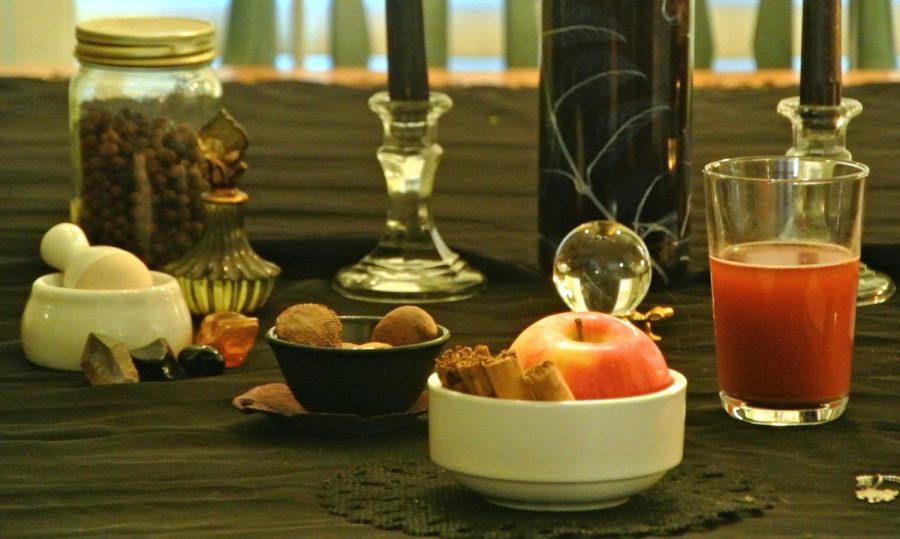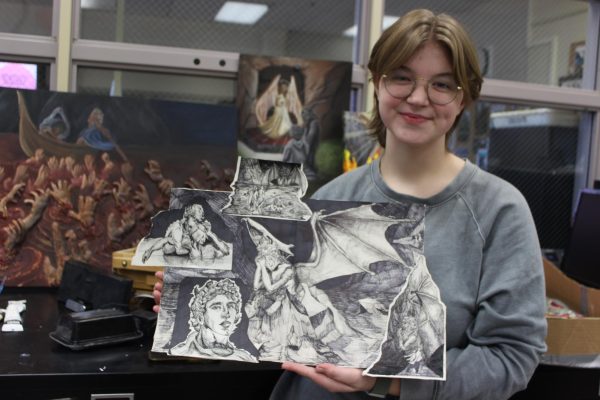The Basics of Samhain: What the Holiday is and How it’s Celebrated
The Wheel of the Year is organized by eight sabbats, which are celebrations on the biannual solstices (summer and winter) and equinoxes (spring and autumn) as well as halfway points in between each solstice and equinox. Samhain (pronounced SOW-in) was a sabbat that recently occurred on Halloween (Oct. 31). Samhain is derived from Gaelic, and when translated means “summer’s end,” so the festival is often celebrated as the beginning of the old Celtic and Wiccan New Year. This is because the holiday marks the beginning of the dark half of the year and the end of the harvest season.
Beliefs
According to “The White Goddess,” an online resource for Witches and Wiccans, it’s believed that on Samhain, the veil between the mortal and spiritual worlds is the thinnest, which allows spirits of the dead to pass freely between the two worlds. Thus, Samhain has also become a day to celebrate the lives of those who have passed.
Samhain, being the beginning of the new year, is a time for personal reflection and releasing things from one’s life that they do not want to bring into the new year. It is common to let go of bad relationships, make amends and get rid of the negativity that surrounds one’s life before entering the new year.
Traditions
Also according to “The White Goddess,”, a walk through nature is also included in the celebration of Samhain. Like any of the eight holidays on the Wheel of the Year, it is heavily centered around nature and therefore, those who celebrate take time to connect with the Earth. A walk through nature to take time to appreciate the colors, sounds, textures, and energy is considered a perfect way to reconnect with the Earth.
What’s known as a “dumb supper” is another celebration in Samhain that focuses on connecting with the spirits of those who have passed. During this tradition, people are usually served a three-course meal and those at the table do not speak until the supper is finished. This is meant to serve the purpose of allowing the energies of the spirits to pass through the air and be welcomed into the space. During dumb suppers in Ireland, doors and windows are left unlocked, cakes are set out for the dead and after the meal, the family will discuss the events of the previous year for their ancestors, according to Diana Rajchel’s “Llewellyn’s Sabbat Essentials: Rituals, Recipes & Lore for Samhain.”
An act of divination is also accustomed to Samhain. Because Samhain is the new year in the Wheel of the Year, many celebrating seek guidance from tarot cards, runes or other items of divination. This is often done in order to set the tone for the New Year and allows one to receive guidance and insight into what their year will be like.
Because Samhain occurs during the fall, the items and practices that are associated with the holiday are autumnal-themed. Pumpkins, autumn leaves, corn husk dolls and acorns are all items that are commonly found in traditions and practices that surround Samhain.
Since nuts are plentiful during the season, many Samhain traditions include various types of nuts. One example of this tradition is two hazelnuts, which are named after a couple and then thrown into a fire. Rajchel explains that it was believed that the pair would have a happy marriage if the nuts burned together, an unhappy marriage if the nuts failed to ignite and that they would face arguments in their marriage if the two nuts jumped apart from each other once burned.
In addition, many different-colored candles are burned during the celebration, which usually includes black, white, orange and other deep colors. According to Witchipedia, an online encyclopedia of “witchcraft, paganism and the occult,” the associations with the colors of the commonly burned candles include a banishment of negative energy and death (black), the cycle of life and divinity (white), as well as the harvest season and a breakdown of barriers (orange). In addition, deeply colored crystals such as onyx, obsidian, and bloodstone are common, in addition to sandalwood incense.
Origins
The Ancient Celtic era spanned from approximately 1400 B.C.E. to 500 A.D., according to Barry W. Cunliffe’s “The Ancient Celts.” Most ancient Celts were polytheistic and had four fire festivals that they celebrated throughout the year. After the first frost of the first full moon in October, the Ancient Celts would light hearth fires and allow them to burn out. They believed that all creatures could move through the “mortal world” on Samhain night, so the Celts would dress up as animals and other things to ward off faeries and witches, which they believed would kidnap them, according to Rajchel.
According to an online edition of “The Catholic Encyclopedia,” St. Pope Boniface I followed St. Augustine’s (who was his contemporary) efforts against paganism. This included redirecting Samhain to be a holiday that honored saints and martyrs instead of the spirits and the dead and moving the celebration from late October to May 13. The Celtic fire festivals continued despite this, so Pope Gregory IV moved the saints and martyrs day to the same day that Samhain occurred in the early ninth century. Nov. 1 then became known as All Saints’ Day, and over the next few hundred years, the night before would come to be known as All Hallow’s Eve in Ireland.
According to Rajchel, during the Middle Ages in Wales, those who went out on Samhain night carried turnips on strings with a piece of burning coal inside, which were known as jack-o-lanterns, coming from an early Celtic Christian legend about a blacksmith called Old Jack, who was refused by both heaven and hell because he was so evil. Since his only other option was purgatory, he would roam around during Samhain night with a turnip lantern being his only light. As the Irish and other ethnic groups from Great Britain began to emigrate in the millions to America, British Isle immigrants carried on many of their traditions in the United States, including jack-o-lanterns. In America, pumpkins were used instead of turnips since they were much more common.







